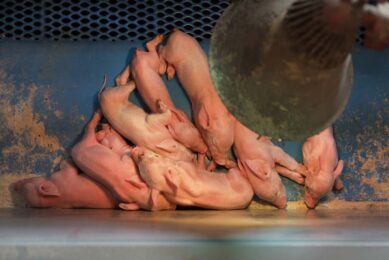Zinc oxide in weaner pigs – Decision day is approaching

A momentous decision on zinc oxide is likely to be made in the European Union. Will it be a reversal of the plan to ban all products containing zinc oxide, will the ban be delayed or will it be implemented immediately? We are all waiting to see. Health expert David Burch has last, pressing advice for everyone on the committee.
The Veterinary Medicinal Products Standing Committee of the European Commission will be meeting in June (19th) and the momentous decision on zinc oxide is likely to be made. Will it be a reversal of the opinion of the Committee on Veterinary Medicinal Products (CVMP) to ban all products containing zinc oxide, or will they delay the introduction of the ban or will it be implemented immediately – we are all waiting to see?
Welfare of millions of piglets
It will be a momentous occasion for pig production in the EU, potentially affecting the health and welfare of millions of piglets. Fortunately, a number of groups share my opinion and I have to thank the Committee of Professional Agricultural Organisations (COPA) for supporting it and lobbying hard the authorities in the member states and the European Commission to reverse the decision or postpone its implementation by up to 10 years.
Ultimately, the Standing Committee will make the decision, so in these last few remaining weeks encourage them and inform them of the significance of this decision, which appears to be primarily a political decision driven by France and the Netherlands. It is unfortunate that many member states appear to accept many of these decisions without challenging them.
Environmental concerns around ZnO
The main driver has been concerns of environmental contamination by the use of zinc oxide in feed, which is eventually passed out in faeces and may be spread on the land. We respect the French and Dutch concerns and they should be allowed to impose national restrictions, if they feel it is an issue.
Denmark also produced data, which said there was an accumulation in their own land. However, they produce 11.6 times the number of weaners than the average per million human population in the EU, so it may not be surprising in a small country.
High zinc concentration bears relationship to mining
In many other member states, where zinc concentrations in the soil have also been measured, there have been substantial deficiencies found, where the soil is used for growing crops and grazing animals on grass, and high zinc concentration bears no relationship to pig production but to mining and industry.
The way the Danes assessed the zinc concentrations and its soil binding and the potential future risk calculations, not to set standards, have been challenged by the International Zinc Association based in Brussels, which also makes the Danish assessments potentially unsound. Advice on the product label would also help mitigate the problem by half if the manure is applied every other year to the soil – halving the application rate.
Resistance concerns
Methicillin-resistant Staphylococcus aureus (MRSA) was highlighted as a concern. The Danes have seen an increase in MRSA incidence in their herds from 3% to 68% and this was thought to be associated with the use of zinc oxide. Work in Canada did show that the therapeutic use of zinc oxide did temporarily increase the recovery of MRSA from nasal swabs two weeks after weaning but they reduced to close to zero by 4 weeks.
Figure 1 – Comparison of zinc oxide inclusion rate and efficacy to prevent diarrhoea.

The nutritionally fed zinc oxide pigs showed a similar relative increase by two weeks and a disappearance by 4 weeks. This is more an indication of nasal bacterial flora dysbacteriosis, which is also going on in the intestines at the same time post-weaning, which is the reason that zinc oxide has been so widely used to prevent diarrhoea.
MRSA CC398 incidence and zinc oxide?
MRSA CC398 the main livestock associated one is a clonal complex (CC). Its increased incidence and spread in Danish herds is not due to zinc oxide use and resistance selection, as it has to be spread by direct contact, i.e. by movement of pigs (growers or breeding stock) to other farms. It was shown in 2012 by a Danish expert scientist group around Carmen Espinosa-Gongora that they are farm-specific lineages.
Regarding Escherichia coli, even therapeutic use of zinc oxide does not appear to have a direct affect on the bacteria but does appear to prevent overgrowth and adhesion to the gut of the entero-toxic E. coli (ETEC) by stabilising the gut flora and increasing the diversity of strains. Antibiotic use has a far greater resistance selection than the indirect co-selection by zinc oxide.
Efficacy – does it work?
The simple answer is – yes it does.
This detailed work involving 10 different references clearly showed that nutritional inclusion levels of zinc oxide of 1,000 ppm and below had no effect, which was the identical finding to my own work using growth performance as the measure of efficacy. Therapeutic concentrations of 2,400 ppm zinc oxide had a definite effect reducing the relative risk of diarrhoea overall by 65%.
This work can hardly be considered publishing bias as it involves 10 separate references and it is also the general opinion of the thousands of farmers that continue to use the product, in the case of the UK, for over 25 years.
Appeal to pig farmers and vets
I appeal to farmers and their vets to inform and advise their national members of the Standing Committee of the European Commission to veto this proposal to ban zinc oxide, to either reverse the decision or to give time until work has properly been carried out in the EU to assess the real impact of pig manure in their countries on zinc levels in the soil.
It would also give time for farmers and research groups to evaluate alternatives, without resorting to going back to the use of antibiotics like colistin and without damaging the health and welfare of millions of pigs and the productivity and profitability of the EU pig industry.
Join 18,000+ subscribers
Subscribe to our newsletter to stay updated about all the need-to-know content in the pigsector, three times a week. Beheer
Beheer











 WP Admin
WP Admin  Bewerk bericht
Bewerk bericht